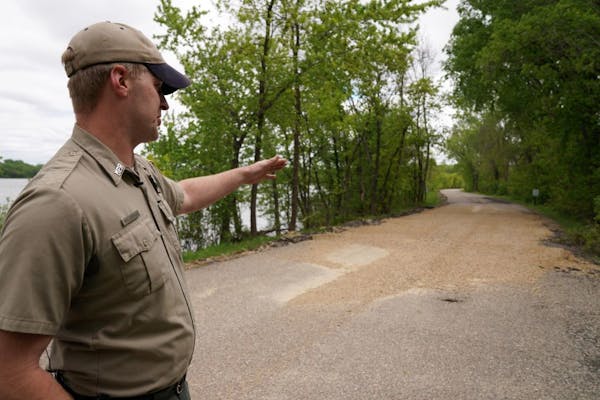The fishing was slow as William Crosby stood on the newly repaired pier at Fort Snelling State Park.
But it didn't matter.
The south Minneapolis man was just happy to be back at the park, which reopened Tuesday amid sunny skies and 80-degree temperatures after being shut down for six months.
The state park, which attracts about 1 million visitors a year and is one of the busiest in Minnesota, closed in March when persistent spring flooding made much of it impassable and caused extensive damage. With most repairs done, bicyclists, hikers and those looking for a picnic spot on a warm September day eagerly wandered the grounds and along the water's edges.
For Jim Bear Jacobs, it was good to be back on sacred ground — Bdote. Holding a shell filled with burning sage, the racial justice director for the Minnesota Council of Churches led a Healing Minnesota Stories tour group to the edge of the Mississippi River.
It was here at this site — the confluence of Minnesota and Mississippi rivers — where 1,700 Dakota elders, women and children were imprisoned during the winter of 1862, he told the group. Hundreds died; those who survived were loaded up on cattle barges and forever banished from Minnesota, he said. "I've led more than 25 tours this year, but there was something missing," he said, noting the tour's absence from the grounds. There's a spiritual energy here, Jacobs said. "It good to touch the earth where our stories are held."
Jacobs lightly touched a tree stump, deeply carved and scarred from barge ropes that had been tied there.
Barges also brought slaves to soldiers serving at Fort Snelling, explained Danny Givens, pastor of Above Every Name Ministries and the co-leader of the Healing Minnesota Stories tour.
Eventually, former slaves traveled upstream on rafts, searching for a new start in the North, said Givens, standing barefoot in the soft river sand.
For Givens and Jacobs, the stories are best told on the land where lives were altered.
Minutes earlier, assistant park manager Nick Bartels stood at the Visitor Center in front of media cameras and microphones, formally marking an end to the longest stretch of time the park has been closed due to flood damage since 2014, when it took about a month for cleanup and repairs.
This year, the rivers didn't drop from flood stage until mid-June, leaving behind major damage. Sections of the park's main road were washed away. The fishing pier on Snelling Lake was pushed 50 feet off its anchor posts and shoved into trees on shore. Trees were downed, trails and parking lots were covered in silt — 2 to 3 feet high in some places — and part of the water main dropped into the Minnesota River.
Park staff and others spent hundreds of hours restoring the grounds, rerouting the water main, clearing 850 cubic yards of silt and repairing the roads and trails. During that time, the park's forced closure likely meant the loss of about 500,000 visitors and $230,000 in revenue, Bartels said.
Although most of the cleanup and repair work is done, a few areas remain closed or partly closed.
That won't keep droves of people from returning to a place that some say feeds their soul.
Amid the green canopy, ash and oak trees are beginning to show their fall colors along rivers that are still high and flowing fast for this time of year. By the late Tuesday afternoon, 258 cars had passed through the park's gates — double the normal number for a weekday.
Steve Aller came by bike — a 5-mile trek from his St. Paul home. Despite the park's closure, he was among those who walked and biked through the park most of the summer, navigating around the debris and washouts. But on Tuesday, he brought his fishing pole for the first time this season, stopping at various fishing spots throughout the park.
Like others who come to Fort Snelling, he revels in the feeling of seclusion while standing amid a natural landscape that offers glimpses of wildlife. "It's just a cattle drive at other parks," he said. "This is the nicest park in the city. You can get away from everything."
Back at the fishing pier, Crosby had packed up his gear with a promise that he would return the next day with his 6-year-old son after school was out. They'll come to fish but they'll take in all the sights — maybe turkeys or deer — that come with standing in the river watershed.
"My son loves it," he said.

A tale of 124 hoarded Minnesota cats has at least a hundred happy endings

Walz, St. Paul leaders urge support for copper wire theft bill: 'We've got to get in front of it'
Body of missing canoeist, 15, recovered from southwest Minnesota lake

High winds flipped a FedEx truck traveling on Bong Bridge in Duluth

